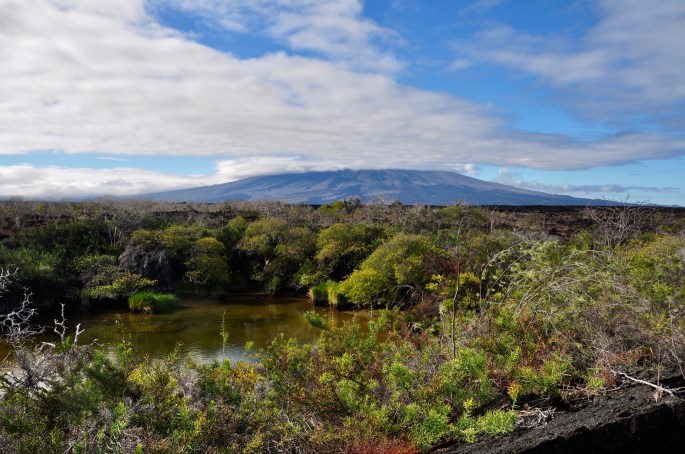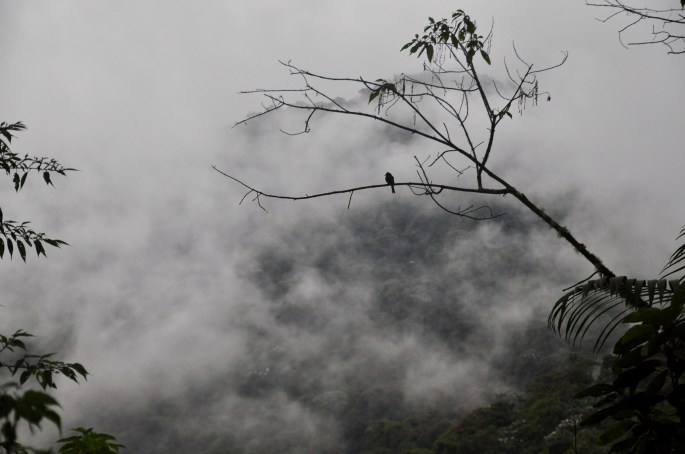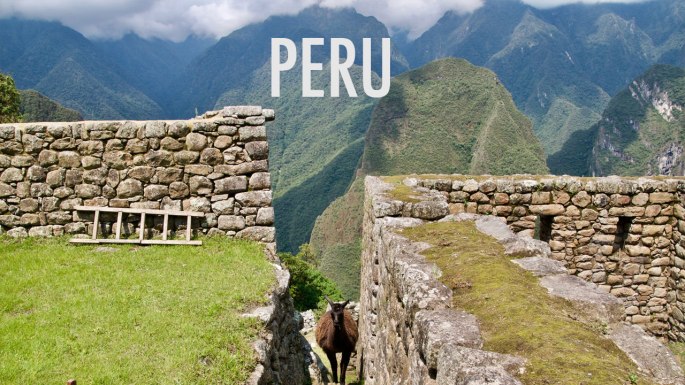Day 5: Punta Moreno & Elizabeth Bay on Isabela island
We came upstairs for breakfast and were treated to a spectacular view when we looked out the window: blue skies and Volcan Azul (blue volcano). We sailed through the night round the south of Isabela island arriving at Punta Moreno. Apparently the trip was meant to take 10/11 hours but only took 7 and a half because conditions were a lot better than usual.
We set out early for our morning hike and as we neared the shore on the zodiac, we saw a mother pelican land in the nest to feed her young by opening it’s huge mouth to pass on the regurgitated food. I have never seen anything like it! Though our view was slightly obscured by the trees, we still glimpsed the baby’s neck all the way inside the mother’s mouth and I even managed to take a photograph that I’m really proud of!
This part of the island is covered in lava rock from the nearby Volcan Azul. It was a landscape that we had never seen before; black, broken and barren. It can take upwards of 200 years following an eruption before the vegetation really starts to grow. Given it erupted as recently as 2008 only a few cactus plants were to be seen. There are three types of cactus found in the Galapagos, here was where we saw the Lava cactus for the first time, each plant often had different coloured parts.
It was really surprising to see pools of water quite far inland that seemed completely cut-off from the ocean. It was even more surprising to see several Galapagos ducks swimming around in them. As we neared the sea, there were a few larger rock pool lagoons. We were so lucky to find the largest pool full of incredible marine life; 2 white tipped reef sharks, one sea turtle, 3 pufferfish and a sting ray! When the tide changes, these animals would make their way back in to the ocean.
After the hike, we had a quick change in to our wet suits ready to snorkel. As we were now properly in the west of the Galapagos archipelago, the water temperature dropped a huge amount. It was bloody freezing but still worth persevering through. We saw lots of huge sea turtles chomping on the algae on the rocks. I saw a massive hieroglyphic hawkfish too which has a really striking blue and yellow pattern. I was in my own little world when we were snorkeling and rarely bothered to come up to the surface to see where everyone else was. When I finally surfaced, I realised that our whole group apart from me and one other had bailed because the water was too cold. Unlucky for them because that’s when I saw a Galapagos penguin streak past me!
In the afternoon, we went out wildlife spotting on the inflatable zodiac motor boats around Elizabeth Bay. As we entered the mangroves, a couple of Galapagos penguins were hopping through the water in front of us, with a playful sea lion close behind! This sea lion seemed to love the attention and had great fun swimming and twirling around our boat. He kept popping his head out of the water as if to check we were still watching.
We went through the shallow, mangrove-lined waters, turned off the engine and then paddled. We saw SO many sea turtles, it was absolutely mad! You could look in any direction and were guaranteed to see a turtle pop it’s head out the water, we’d often count 6 together at once. We’ve now seen a lot of sea turtles when snorkeling (which still fascinates me every time) but it was really nice to get a different perspective and see them from the surface. Also where else in the world would you see sea turtles, sea lions and penguins swimming alongside each other?!
It was here that we saw the rare flightless cormorant! Even within the Galapagos, this bird can only be found in the western part. The bird has evolved to have these absolutely tiny, stumpy wings but the largest body of all cormorants. In the Galapagos, the cormorant lost it’s ability to fly because there was so need when searching for food, another of the incredible bits of evolutionary evidence the Galapagos has to offer. This was particularly special for me as it was actually the Cormorant bird I first saw in Byron Bay, Australia that got me in to bird watching and downloading bird guides! We also saw some more species of heron (the lava heron and Great blue heron), Blue footed boobies and even some really young white fluffy chicks.
As we got back on the boat and began sailing north, we got to enjoy our first beautiful sunset of the Galapagos with clear skies! Join us next time as we head along the coast of Isabela island to Tagus Cove.
Thanks for reading,
Sophie & Dave

Sunset through the boats exterior

Hieroglyphic Hawkfish

Bullseye Pufferfish

A Galapagos Penguin

Turtle gliding effortless through the water

Us with Cerro Azul as the backdrop

White tipped reef shark

Stunning scenery of Punta Moreno

Volcano views

One giant leap for mankind

Sting Ray

Cactus plants

Turtle popping his head out the water to breath

Great Blue Heron

White tipped reef shark

Flightless Cormorant

Group photo

Blue footed booby

Elizabeth Bay

One of the salt water lagoons

Blue footed booby’s

Flightless Cormorant with its redundant wings

Flightless Cormorant closeup

Lava Heron

The water makes the turtle shell look like a painting

Baby pelican fully submerged in his mothers beak

Punto Moreno coastline

Stunning sunset

Punto Moreno scenery

A Galapagos Penguin

Gorgeous sunset

Pelican with its young

Juvenile blue footed booby’s

Pelican feeding its young

Dave on the zodiac

A Galapagos Penguin keeps a close eye on us

Volcano

































































































































































